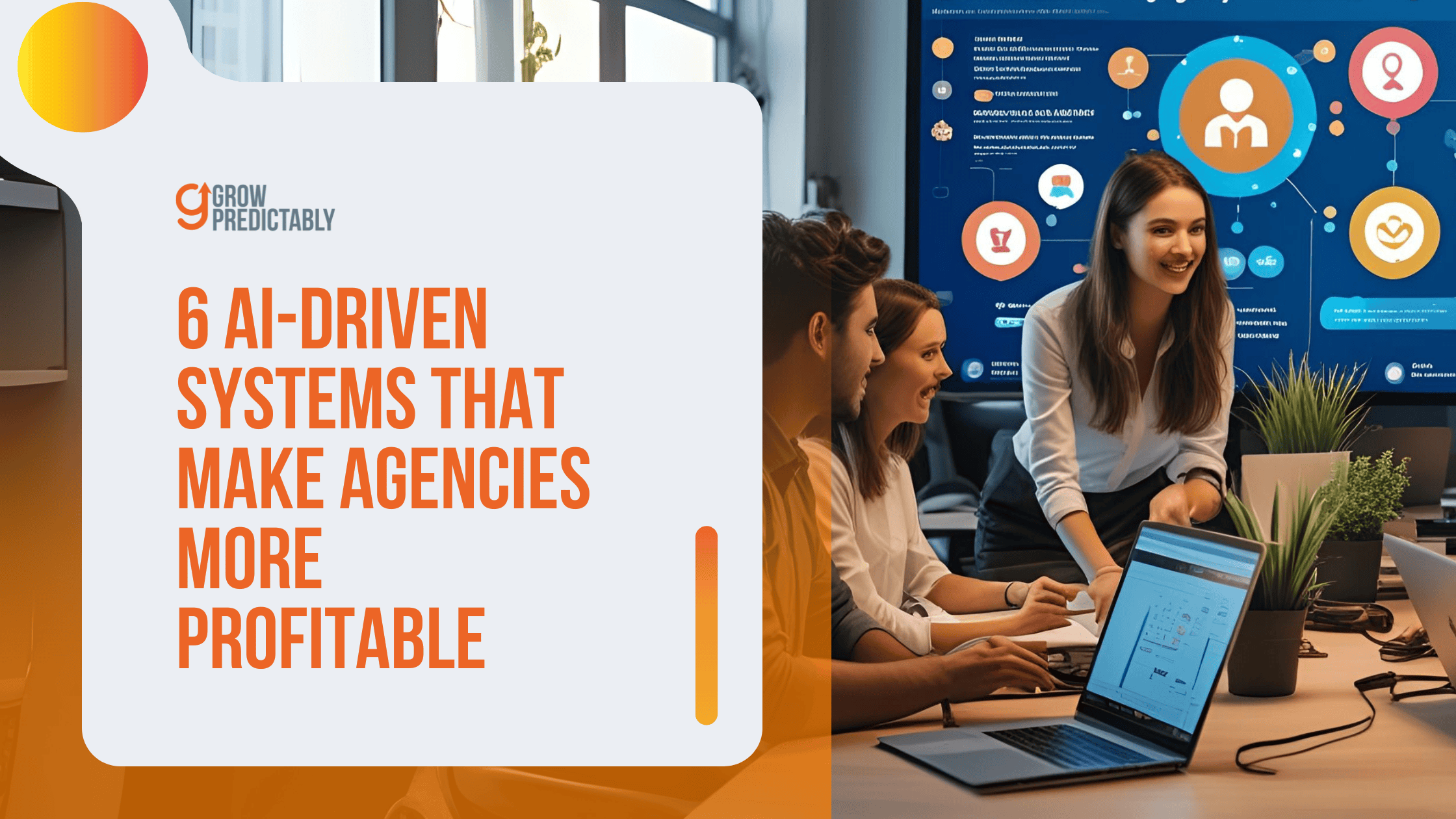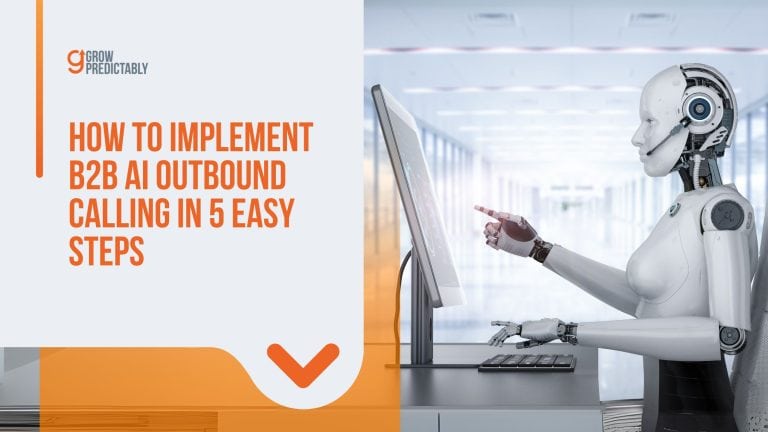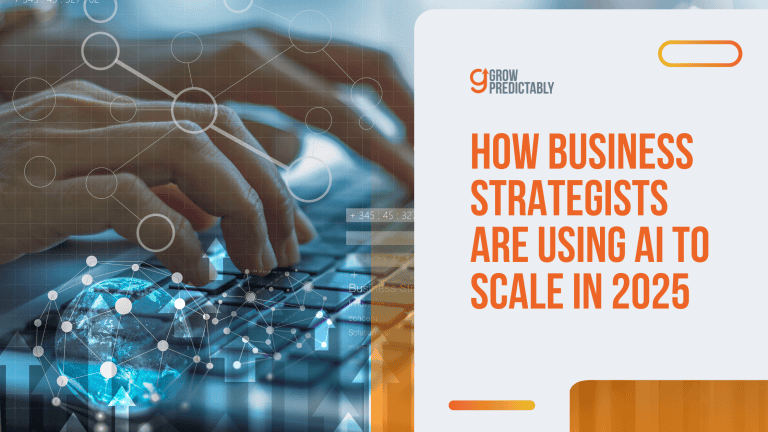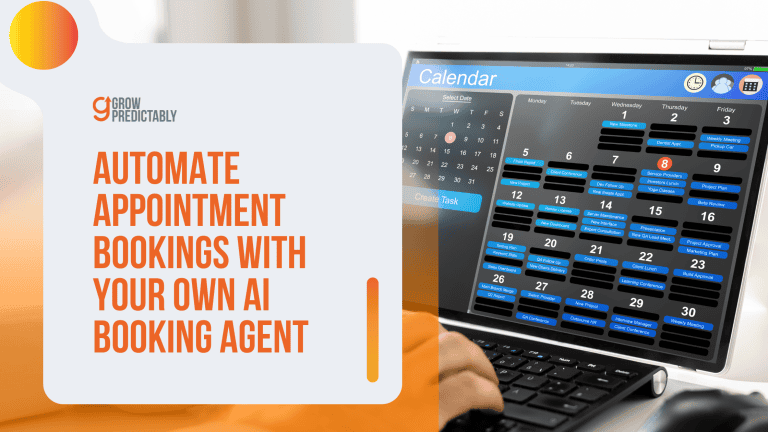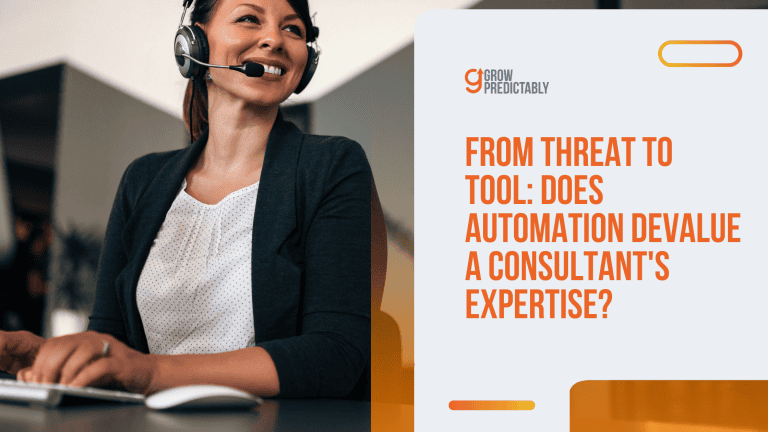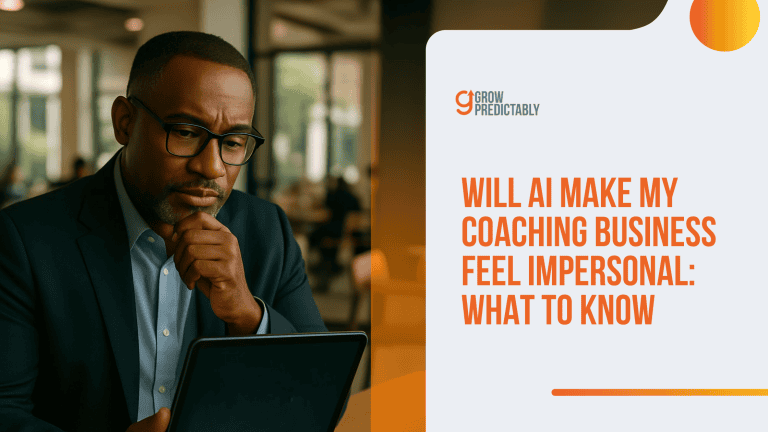6 AI-Driven Systems That Make Agencies More Profitable
You’re probably thinking more clients equals more profit, but here’s the truth: it’s about making every client require less effort while delivering bigger returns.
How can AI and automation help your agency become more profitable?
The answer lies in six game-changing systems: automated client onboarding that cuts setup time from 10 hours to 2, AI-powered content creation that doubles output without adding staff, predictive ad spend optimization delivering 32% higher ROI, 24/7 lead qualification boosting conversions by 20%, automated reporting reducing manual work by 85%, and competitive intelligence automation increasing campaign performance by 25%.
These systems transform agencies by creating a 37% increase in overall profitability within six months, with teams saving 15-20 hours weekly on repetitive tasks while serving 30% more clients with the same headcount.
Let’s transform your operations from time-consuming tasks to profit-generating systems.
TL;DR
To boost agency profitability with AI, focus on automating client onboarding, content creation, and lead qualification, which are high-impact but time-consuming tasks. By implementing AI-driven systems, agencies can increase efficiency, improve client retention, and expand capacity without the need for proportional staff increases.
KEY TAKEAWAYS
- Start by automating repetitive tasks such as client onboarding and reporting to free up valuable hours for strategic work.
- Introduce AI tools like Jasper or ChatGPT for content creation to scale production while maintaining quality and creativity.
- Use AI-powered lead scoring and predictive CRM systems to enhance lead qualification and improve client retention, driving revenue growth.
Defining AI and Automation in the Context of a B2B Digital Marketing Agency
What if you could cut your client onboarding time by 80% overnight?
Picture this: Your team spends 10 hours every week manually onboarding new clients – creating accounts, setting up tracking, building initial reports.
That’s 40+ hours monthly of skilled talent focused on repetitive tasks instead of strategy.
Now imagine turning that into a 2-hour automated flow, freeing up 32 hours each month for high-value work that directly grows your bottom line.
This isn’t some far-off dream.
It’s happening right now in agencies that have embraced AI and automation.
What Are We Really Talking About?
When we talk about AI for your agency, we mean software systems designed to perform tasks that typically require human intelligence.
Think of artificial intelligence as your digital team member that can:
- Analyze campaign data to spot performance trends in your marketing efforts
- Generate first drafts of client content
- Predict which leads are most likely to convert
- Recommend optimization tactics based on past results
Automation, meanwhile, is about creating systems that execute repetitive tasks without manual intervention.
It’s the difference between manually sending welcome emails to each new client versus having them automatically triggered when a contract is signed.
Together, these marketing automation tools form a profit-boosting backbone for forward-thinking agencies.
Real-World Examples in Agency Life
Let’s make this concrete with examples you’ll recognize:
| Agency Function | Before | After |
|---|---|---|
| Client Onboarding | 10 hours of manual setup, document creation, and account provisioning | 2-hour automated flow with triggered emails, self-serve portals, and auto-generated accounts |
| Performance Reporting | 8 hours monthly per client pulling data, creating visualizations, writing insights | 45-minute review of auto-generated reports with AI-suggested insights |
| Content Creation | 6 hours for a single blog post from research to publishing | 2 hours to review, refine and personalize AI-generated drafts |
This isn’t about replacing your team – it’s about upgrading how they work through marketing automation, helping you evolve into an AI marketing agency.
Your strategists spend less time on spreadsheets and more time on strategy, focusing on meaningful customer interactions.
Your writers focus on creativity and client voice rather than fighting blank pages.
The Profit Connection
The math is simple but powerful:
When your team spends less time on repetitive tasks, you can either:
- Serve more clients with the same headcount
- Reduce overtime and burnout
- Focus on higher-value services that command premium rates
Each path leads directly to stronger profit margins.
According to Adobe, businesses that rely on automation enjoy 25% higher revenue, a trend also seen in successful marketing agencies. (Source)
Why This Matters Right Now
This isn’t some futuristic technology you can afford to adopt “someday.”
The competitive gap is widening: agencies embracing these tools are scaling faster with lower overhead costs while delivering results more consistently.
Think about your current workflow challenges:
- How many hours does your team spend on repetitive tasks?
- Where are the bottlenecks that slow down client deliverables?
- Which processes feel inconsistent because they depend on who’s handling them?
Each of these pain points represents a profit leak that AI and automation can help plug.
How exactly does saving all these hours translate to higher profits?
The answer might surprise you – and we’ll explore the precise profit impact in the next section.
For now, know this: the agencies seeing the biggest gains aren’t necessarily the largest or most technically advanced.
They’re simply the ones who identified their most time-consuming processes and applied the right tools to streamline them.
Ready to see which specific use cases could transform your agency operations?
The “Key AI and Automation Use Cases” section ahead will show you exactly where to start for maximum impact.
How AI and Automation Directly Impact Agency Profitability
Ever wonder what that 80% reduction in client onboarding time we mentioned actually means for your bottom line?
Let’s translate those hours saved into dollars earned.
The Real Cost of Manual Agency Operations
Running a B2B digital marketing agency without artificial intelligence and automation services in your arsenal is like rowing a boat upstream—exhausting, inefficient, and ultimately limiting your growth potential.
The numbers tell a painful story:
- Your team spends 15+ hours weekly on repetitive tasks that don’t directly generate revenue.
- Unpredictable client acquisition creates feast-or-famine cash flow cycles.
- Manual processes lead to inconsistent results and eventual client churn.
- Your best people burn out handling work that could be automated.
Which by the way can all be eliminated by automation agencies…
But there’s good news!
The shift from manual to automated isn’t just about convenience—it’s a direct path to higher profits.
Here are four profit multipliers powered by AI.
1. Dramatic Labor Cost Reduction
AI doesn’t just save time—it saves money by reallocating expensive human hours to high-value work.
| Task | Manual Process | With AI Automation | Savings |
|---|---|---|---|
| Client reporting | 8 hours/week | 1.5 hours/week | 81% time reduction |
| Content creation | 12 hours/project | 4.5 hours/project | 62% cost savings |
| Campaign setup | 6 hours/client | 2 hours/client | 67% efficiency gain |
Real-world impact
Organizations using AI writing tools report an average 59% reduction in time spent on basic content creation tasks. (Source)
2. Enhanced Client Acquisition
Still spending hours manually qualifying leads that go nowhere?
AI-powered targeting changes the game.
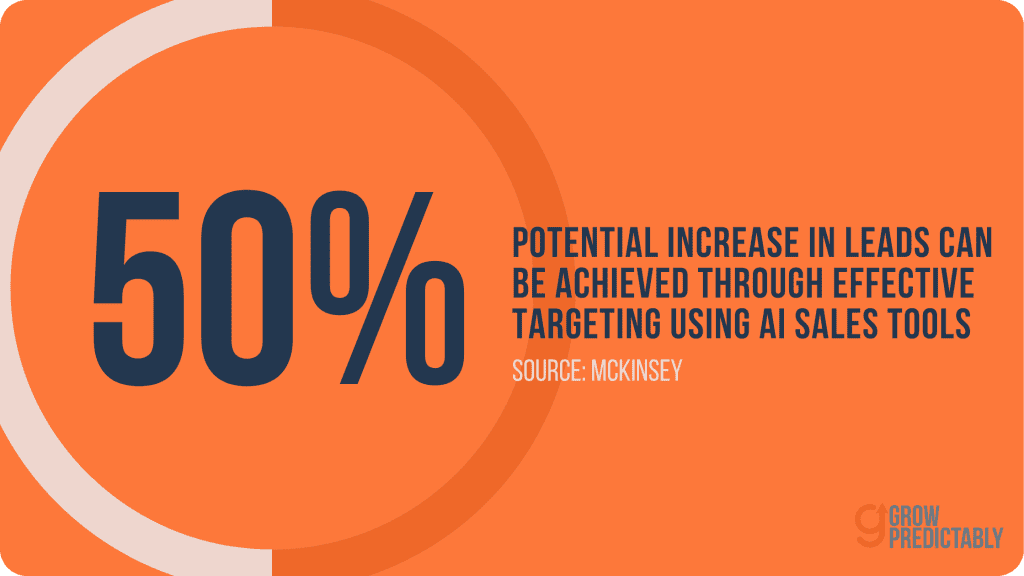
AI-powered lead scoring and qualification tools identify your most promising prospects based on behavior patterns and engagement signals, thereby boosting the efficiency of sales teams.
This means:
- 22% higher conversion rates from initial contact to paying client (Seamless.AI, 2023).
- 35% reduction in time spent pursuing poor-fit prospects.
- More predictable revenue forecasting based on qualified pipeline.
One small agency founder put it perfectly: “We now close 1 in 4 leads instead of 1 in 10—with the same team size.”
3. Quality Improvement That Clients Notice
Artificial intelligence doesn’t just work faster—it works better.
By analyzing patterns across campaigns and client accounts, AI tools can:
- Identify underperforming content before it wastes your client’s budget.
- Spot optimization opportunities humans might miss.
- Maintain consistent quality even during team transitions.
This quality lift translates to tangible profit through:
- 18% higher client retention rates (Marketing AI Trends, Statista 2023).
- Increased upsell opportunities from satisfied clients.
- Stronger referral business from impressed partners.
4. Revenue Scaling Without Proportional Hiring
The holy grail of agency growth?
Increasing revenue without equally increasing headcount.
AI makes this possible:
![Revenue vs. Headcount Graph with AI Automation]
When agencies implement comprehensive AI systems, they typically see:
- 30% more client capacity with the same team size.
- Ability to take on larger clients with more complex needs.
- Higher profit margins as revenue outpaces operational costs.
Beyond Efficiency: The Compound Effect on Profitability
The profit impact of AI isn’t just about individual task savings—it’s about the compound effect across your entire AI agency.
Consider this example from a mid-sized B2B agency:
| Metric | Before AI | After AI Implementation | Change |
|---|---|---|---|
| Average client value | $4,200/month | $4,950/month | +18% |
| Team capacity | 12 clients per strategist | 16 clients per strategist | +33% |
| Client retention | 72% annual | 86% annual | +14% |
| Gross profit margin | 42% | 58% | +16% |
The combined effect?
A 37% increase in overall profitability within six months.
Common Agency Pain Points Solved
Are you facing these familiar challenges?
AI directly addresses them:
- Unpredictable revenue cycles: AI-powered lead scoring creates more reliable sales pipelines.
- Team burnout: Automation eliminates the repetitive tasks causing staff fatigue.
- Client churn: AI-driven insights help you deliver more consistent, data-backed results.
- Scale limitations: Break through capacity ceilings without proportional hiring.
Still spinning your wheels writing every blog post manually?
Or spending Sundays catching up on client reports?
Those days can be behind you.
The Mindset Shift: From Cost Center to Profit Driver
The most successful agency founders don’t view AI as an expense—they see it as a profit-generating investment.
When properly implemented, every dollar spent on AI tools returns multiple dollars in:
- Recovered billable hours
- Higher-value service delivery
- Expanded client capacity
- Reduced operational overhead
Think 20% savings is good? That’s just a standard with advanced automation tools.
Let’s explore plug-and-play automation workflows that can transform your operations within days, not months.
6 Ways AI + Automation Can Make Your Agency More Profitable
Ever wonder what separates thriving agencies from those struggling to keep up?
The secret isn’t just working harder—it’s working smarter with AI automation services and maximizing efficiency.
Let’s jump into the exact AI solutions and use cases that are changing the game for B2B marketing agencies right now!
1. Automating Client Onboarding
Automating client onboarding when a new client comes on board, the initial setup can really bog down your team—something automation agencies strive to optimize.
It’s a lot of juggling—collecting documents, setting up kickoff calls, and making sure everything is ready to go, all of which eats into precious billable hours.
Streamlining this process can not only save you time but also enhance the client’s first experience, setting the stage for a long-term partnership.
- Problem: New clients require hours of manual setup, document collection, and kickoff coordination—eating into billable time.
- Tool in Focus: Zapier + HubSpot AI
- Profitability Outcome: Transforms a 10-hour manual process into a 2-hour guided experience.
| Time Saved | Team Size Fit | Client Impact |
|---|---|---|
| 6-10 hours per new client | Works for solo to mid-size teams | Higher client satisfaction from Day 1 |
When a client signs, trigger automated welcome emails, schedule kickoff calls, and collect necessary information through smart forms. This not only saves time but creates a premium first impression that justifies your rates.
2. Content Creation and Scaling
We all know that quality content doesn’t just appear out of thin air. It takes time and effort to tailor content for each client, especially as the workload grows.
By optimizing your process, you can produce more content in less time without sacrificing quality or burning out your team.
This means more output, happier clients, and the ability to scale efficiently.
- Problem: Creating quality content for multiple clients is time-intensive and difficult to scale.
- Tool in Focus: Jasper or ChatGPT
- Profitability Outcome: Cuts campaign creation time by 50%, allowing you to double content output without adding staff.
| Time Saved | Team Size Fit | Client Impact |
|---|---|---|
| 15-20 hours per week | Perfect for small teams | Faster turnaround on deliverables |
Instead of starting from scratch, use AI to generate first drafts, create content variations, and repurpose existing content across platforms.
One agency owner told me, “I can now handle content for 8 clients with the same team that used to handle 3.”
3. Predictive Ad Spend Optimization
Managing ad campaigns is a bit like playing chess—every move counts, and one wrong move can be costly.
Instead of getting caught in the weeds of manual adjustments and overspending, you can focus on strategies that actually move the needle.
By optimizing how you manage campaigns, not only do you cut waste, but you also improve results, making your efforts more impactful for your clients.
- Problem: Manual campaign management leads to wasted ad spend and suboptimal results.
- Tool in Focus: Madgicx
- Profitability Outcome: Delivers +32% ROI from hypertargeted ads based on historical performance data.
| Time Saved | Team Size Fit | Client Impact |
|---|---|---|
| 8-12 hours per week | Best for scaling agencies | Improved campaign performance and client retention |
Employ predictive analytics to analyze past campaign data and predict which audiences, creative approaches, and budget allocations will perform best.
4. 24/7 Lead Qualification
Let’s face it: we can’t monitor our websites every second of the day.
However, without immediate follow-up, potential leads might just slip through the cracks.
By ensuring that every visitor is engaged and qualified in real-time, you provide a seamless experience and increase the chances of supporting your sales teams in converting interest into action, even when you’re not at your desk.
- Problem: Slow follow-up with website visitors leads to lost opportunities that could be addressed by predictive analytics for efficient conversion.
- Tool in Focus: Chatbot.com
- Profitability Outcome: 20% lift in booked demos and qualified leads without adding sales staff.
| Time Saved | Team Size Fit | Client Impact |
|---|---|---|
| 10-15 hours per week | Works for any size | Faster response times increase conversion rates |
Your AI assistant automates customer interactions, qualifies based on your criteria, and books meetings directly into your calendar—even at 2 AM when your team is sleeping.
5. Automated Reporting and Insights
Creating client reports can feel like being stuck in a repetitive loop, taking away from more strategic, big-picture thinking.
Rather than spending countless hours compiling data, you can focus on what really matters—understanding insights, refining your marketing efforts, and preparing for engaging customer interactions.
This shift not only saves time but enhances the depth and quality of your client interactions.
- Problem: Creating client reports is tedious, repetitive, and takes hours away from strategic work.
- Tool in Focus: Google Data Studio + Supermetrics
- Profitability Outcome: Reduces reporting time by 85% while delivering more comprehensive insights.
| Time Saved | Team Size Fit | Client Impact |
|---|---|---|
| 5-8 hours per client monthly | Essential for all agencies | Higher perceived value through better data visualization |
Set up dashboards once, then let the system pull data automatically. You’ll go from spending days on reports to spending minutes reviewing insights before client calls.
6. Competitive Intelligence Automation
Keep tabs on what your competitors are up to shouldn’t feel like an uphill battle when utilizing predictive analytics.
By optimizing how you gather this intelligence, you can quickly pinpoint opportunities to outpace them.
With real-time insights, you’ll have the upper hand in strategy meetings, finding high-ROI avenues to explore and boost client campaigns.
- Problem: Staying on top of competitors’ strategies across multiple clients is nearly impossible manually.
- Tool in Focus: Semrush + Zapier
- Profitability Outcome: Identify high-ROI opportunities faster, increasing client campaign performance by 25%.
| Time Saved | Team Size Fit | Client Impact |
|---|---|---|
| 10+ hours per month | Mid-size to larger teams | Strategic advantage through competitive insights |
Automate monitoring of competitors’ keywords, content, and ad strategies. Get alerts when they launch new campaigns or target new keywords, giving you the edge in client strategy sessions.
What You Just Learned
Each of these AI-powered use cases directly impacts your bottom line by:
- Reducing manual workload without sacrificing quality
- Speeding up delivery timelines to impress clients
- Improving campaign performance metrics
- Directly boosting your gross margin without hiring
The best part? You don’t need a massive team or budget to implement these AI solutions and transform your agency into an AI marketing agency.
Even solo operators and small agencies can leverage these tools to compete with larger firms.
Ready to know which specific tools deliver these results most effectively? We’re unpacking that next.
Which Tool Matches Your Agency Stage?
The right AI stack depends on where your agency stands today:
- Solo Founders: Start with ChatGPT + Zapier to handle the workload of what feels like an extra team member.
- Small Teams (2-5): Add Jasper or Copy.ai to scale content production without hiring writers.
- Scaling Agencies (6+): Implement the full stack, with special focus on Seamless.AI to fuel your growth pipeline.
Want to know exactly how to implement these tools for maximum profit impact? Keep reading—our step-by-step implementation guide is coming up next!
The answer might surprise you when you see our framework for implementing marketing automation.
Step-by-Step Guide to Implementing AI and Automation in Your Agency
Are you ready to turn those AI tools into real profit boosters?
Let’s break down exactly the steps that can turn your agency into an AI agency with this implementation guide through effective automation services.

This isn’t about complex tech – it’s about smart implementation that delivers results fast!
1. Audit current workflows
⏱️ Time to Implement: 2-3 days
💰 Budget to Expect: $0 (internal time only)
📈 Profit Forecast: Identifies 15-20 hours of weekly tasks that could be automated
Start by mapping out where your team spends their time that could be optimized with AI automation services.
Which tasks are repetitive?
Which ones drain creative energy?
Which ones can generate better results with AI solutions?
Look for patterns like:
- Manual reporting that happens weekly
- Content formatting that follows the same structure
- Client communication that uses similar templates
- Data entry between different platforms
🧭 Worried about tech overwhelm?
Most tools require zero coding.
This audit is about finding opportunities, not building complex systems.
2. Select highest-impact processes to automate
⏱️ Time to Implement: 1 day
💰 Budget to Expect: $0 (internal planning)
📈 Profit Forecast: Target 5-7 hours of immediate weekly time savings
Not all tasks are created equal!
Prioritize based on:
- Time consumed weekly
- Frustration level for your team
- Client impact if done faster/better
- Cost of current manual process
Pick 2-3 processes to start with – don’t try to automate everything at once.
Great first candidates include social media scheduling, performance reporting, and content research.
3. Pick tools aligned to team size and margins
⏱️ Time to Implement: 2-3 days
💰 Budget to Expect: $50-300/month to start
📈 Profit Forecast: 10x return on tool investment within 90 days
Match your tools to your agency’s current reality:
- Solo/tiny team? Start with ChatGPT + Zapier combo
- Small agency (2-5 people)? Add Jasper for content scaling
- Growing agency (6-15)? Consider AI-powered CRM and reporting dashboards for enhanced productivity
Remember the tools we covered earlier?
This is where you select the ones that directly address your highest-impact processes.
4. Pilot AI on one channel
⏱️ Time to Implement: 1 week
💰 Budget to Expect: $100-200 (tool + setup time)
📈 Profit Forecast: 3-5 hours saved weekly on first channel
Start small and focused!
Pick one marketing channel to transform:
- Automate Facebook ad reporting
- Use AI to draft email newsletters
- Set up automated client onboarding for one service
This focused approach builds confidence and creates a quick win that gets your team excited about the possibilities.
🧭 Feeling stuck?
Begin with the easiest win – like using ChatGPT to draft social media captions or setting up automatic weekly reporting emails.
5. Train for consistency—build SOPs
⏱️ Time to Implement: 3-5 days
💰 Budget to Expect: $200-500 (documentation time)
📈 Profit Forecast: Prevents $2,000+ in potential rework and errors
Document your new AI workflows with:
- Step-by-step guides with screenshots
- Video walkthroughs for visual learners
- Templates for AI prompts that work consistently
- Clear guidelines on when to use AI vs. human touch
This step is crucial!
Without proper SOPs, your automation efforts will create inconsistent results and team frustration.
6. Measure, iterate, and report impact
⏱️ Time to Implement: Ongoing (1-2 hours weekly)
💰 Budget to Expect: $0-100/month for tracking tools
📈 Profit Forecast: Identifies additional 10-15% efficiency gains
Use predictive analytics to track these key metrics:
- Hours saved per week
- Turnaround time improvement
- Client satisfaction scores
- Team happiness ratings
- Direct cost savings
Sample efficiency gains chart showing how different departments benefit from AI implementation
After 30 days, gather your team to review what’s working and what needs adjustment.
This feedback loop is what transforms good automation into great automation.
Your First 30 Days Plan to Save 20+ Hours & Boost Profit Uplift
| Week | Focus | Action Items | Expected Outcome |
|---|---|---|---|
| 1 | Audit & Select | Complete workflow audit, choose 2-3 processes | Clear implementation roadmap |
| 2 | Tool Setup | Set up first AI tool, create account, connect data | One working automation |
| 3 | First Channel Pilot | Run automation on one marketing channel | 3-5 hours saved weekly |
| 4 | Document & Scale | Create SOPs, train team, measure results | Ready to expand to more processes |
🧭 Worried about quality?
Start by having humans review AI outputs for the first two weeks.
You’ll quickly learn where the AI excels and where it needs guidance.
Master these steps, and you’ll be ready for the real game-changers we cover in our case studies next.
Remember – even small agencies with limited resources can achieve remarkable efficiency gains that directly boost your bottom line.
You will just have to take the lead.
Exactly like what Marc de Swaan Arons said in an interview with ThinkWithGoogle. (Source)
AI transformation is not something that will happen to your organization, but it is something that you as the leader will drive, design, and champion for you and your people.
Marc de Swaan Arons, Founder of Institute for Real Growth
Potential Challenges and How to Overcome Them
You’ve seen the amazing results agencies are getting with AI.
But let’s be real—implementing new tech isn’t always smooth sailing!
Every transformation comes with its bumps in the road.
Let’s tackle the big ones head-on so you can avoid the pitfalls that trip up other agency founders.
Challenge #1: Upfront Costs
The Scenario:
You’re convinced AI could transform your agency into an AI automation agency, but that $500/month enterprise plan makes your stomach drop. With tight cash flow, investing in new tools feels risky.
The Solution:
Start small and prove ROI quickly. Many AI tools offer free or low-cost entry points:
- Begin with ChatGPT’s free tier to test content creation
- Use Zapier’s free plan (up to 5 zaps) to automate one critical workflow
- Track time saved in a simple spreadsheet to quantify value
One agency owner I worked with started with just $50/month in AI tools and tracked $2,700 in saved billable hours in the first month alone. The key? Pick one painful, time-consuming process and automate it first.
Challenge #2: Staff Pushback
The Scenario:
Your marketing assistant’s eyes widen with panic when you mention implementing AI. “Are you replacing me with a robot?” The room goes silent.
The Solution:
Frame AI as a promotion tool, not a replacement:
- Involve team members in selecting and implementing tools
- Co-create new SOPs that show how AI handles the boring work so they can do more creative, strategic tasks
- Celebrate when team members master new AI skills with recognition or bonuses
Try saying: “This tool will handle the 20 hours of reporting you hate each month so you can focus on strategy and client relationships—the stuff only you can do brilliantly.”
Challenge #3: Integration Headaches
The Scenario:
You’ve purchased three different AI tools, but they don’t talk to each other. Data lives in silos, and your team is manually transferring information between systems.
The Solution:
Integrate with your existing systems and build your stack strategically:
- Start with platforms that offer native integrations with your existing tools
- Use Zapier as the “glue” between systems that don’t naturally connect
- Create a visual workflow map before purchasing to identify potential gaps
- Consider hiring a systems specialist for a day to set up proper integrations
One small agency I know avoided months of headaches by spending 2 hours mapping their ideal workflow before buying anything. When they did implement, everything clicked into place from day one.
Challenge #4: Fear of Losing Human Touch
The Scenario:
A client sees an AI-generated email and comments, “This feels robotic. I thought we hired you for your creativity and personal touch.”
The Solution:
Use AI as enhancement, not replacement:
- Develop clear guidelines for when AI drafts vs. when humans craft from scratch
- Always have human review and personalization of AI-generated content
- Be transparent with clients about your process—many appreciate the efficiency
- Reserve high-touch interactions for relationship-building moments
Remember: AI handles the heavy lifting so your human team can add more value where it matters most.
Myth-Buster Box
❌ Myth: “AI is only for big agencies with big budgets”
✅ Truth: A 2-person social media agency using just ChatGPT doubled their content output and increased client retention by 35% in just 3 months. They started with zero budget by using free tools strategically.
Challenge #5: Quality Concerns
The Scenario:
Your AI tool produced a blog post with factual errors and a generic voice that doesn’t match your client’s brand.
The Solution:
- Create detailed brand voice guides for each client to feed into AI tools
- Implement a quality control checklist for all AI outputs
- Use AI for first drafts only, with human editors adding expertise and fact-checking
- Build a prompt library with examples of your best work
One agency cut editing time by 70% by creating a custom “brand voice” template for each client that they paste into every AI prompt.
Every challenge you face with AI implementation is actually an opportunity to create systems that will scale your agency more efficiently than your competitors.
The agencies that push through these initial hurdles gain an almost unfair advantage in profitability and scalability.
As AI continues to evolve at lightning speed, your ability to adapt and overcome these challenges won’t just help you today—it’ll position you perfectly to capitalize on what’s coming next as an AI automation agency.
Speaking of which, let’s look at those future trends.
The Customer Avatar Canvas: Using AI to Know Your Clients Better Than They Know Themselves
Want to turn these trends into profit? It starts with deeply understanding who you’re targeting.
The Customer Avatar Canvas helps you harness AI to build detailed profiles of your ideal clients.

Here’s how it works:
1. Identify
Map out your client’s world in rich detail:
- Demographics: Company size, industry, location, growth stage
- Frustrations: What keeps them up at night? (“We can’t generate quality leads consistently”)
- Aspirations: What are they trying to achieve? (“Becoming the go-to solution in their niche”)
2. Enhance
This is where AI supercharges the traditional avatar approach:
- Use AI analytics to score and segment potential clients based on behavior patterns
- Identify which clients are most likely to convert and expand
- Discover hidden correlations between client characteristics and campaign success
3. Target
Deploy “next best message” engines that:
- Automatically select the optimal content for each prospect
- Time outreach based on engagement patterns
- Continuously refine messaging based on response data
Download the full Customer Avatar Canvas template to apply this framework to your agency
How Small Agencies Are Winning Big With AI-Enhanced Targeting
You might think these advanced targeting capabilities are only for the big players, but that’s not true! Small agencies are often more agile in adopting these technologies.
Take Bright Spark Digital, a 5-person agency that implemented AI-powered customer journey mapping. Within 60 days, they:
- Reduced time spent on audience research by 65%
- Increased client campaign performance by 28%
- Added $8,500 in monthly recurring revenue
Their secret? They focused on one AI capability at a time, starting with the Customer Avatar Canvas to deeply understand their clients’ audiences.
Getting Started With AI-Enhanced Customer Targeting
- Begin with what you know: Feed your existing client data into AI analysis tools
- Look for patterns: What characteristics do your most profitable clients share?
- Build predictive models: Use these insights to score new prospects
- Test and refine: Continuously improve your targeting based on results
The agencies that master this approach aren’t just delivering better results—they’re commanding premium prices because their targeting precision becomes a unique selling proposition.
What’s Next For Your Agency?
You’ve seen how future AI trends will reshape agency work and how the Customer Avatar Canvas can position you to capitalize on these changes.
But knowing about trends isn’t enough—you need a strategic timeline to implement them.
How do you prioritize which AI capabilities to adopt first?
How do you build a roadmap that balances quick wins with long-term transformation?
You’ve seen the trends—now let’s plug them into a strategic timeline that will position your agency for growth in the AI-powered future.
Action Plan: Start Boosting Your Agency’s Profitability with AI Today
Ready to turn all that AI knowledge into real profit?
Let’s map out exactly how you’ll transform your agency—not someday, but starting right now.
Think of this as your step-by-step profit acceleration guide, broken down into bite-sized wins that build on each other and enhance your marketing efforts.
No overwhelming tech changes, just smart moves that directly impact your bottom line.
🎯 Quick Wins (This Week)
Why wait when you can start saving time and making money immediately?
These first steps take less than 3 hours to implement but will free up days of work each month:
1. Set up AI chatbot for lead capture
- Time to implement: 2-3 hours
- Tools: Chatbot.com or ManyChat
- Expected outcome: Qualify leads 24/7 without you being there
- Profit impact: 20% more qualified leads entering your pipeline without adding staff time
2. Automate weekly reporting via Zapier
- Time to implement: 1-2 hours
- Connection: Google Analytics + Sheets + Email via Zapier
- Expected outcome: Reports generate and send themselves
- Profit impact: Save 8-10 hours monthly on manual reporting tasks
Quick win tip: Don’t overthink this phase!
Even imperfect automation is better than none.
You can refine as you go.
📈 Mid-Term Wins (30-60 Days)
Once you’ve tasted those first time savings, you’re ready to make bigger moves that directly impact revenue:
1. Switch content generation to Jasper + ChatGPT
- Time to implement: 1 week of testing and template creation
- Process: Create content frameworks your team can use with AI
- Expected outcome: Triple your content output with the same team
- Profit impact: Deliver more client work without hiring additional writers
2. Use Seamless.AI to qualify leads faster
- Time to implement: 3-5 days for setup and training
- Process: Build automated lead scoring based on your best clients
- Expected outcome: Focus only on prospects with highest conversion potential
- Profit impact: 15% increase in monthly recurring revenue by targeting better-fit clients
Mid-term tip: This is where you’ll see the most resistance from your team.
Involve them in creating the processes rather than imposing changes from above.
🏗️ Long-Term Scalables (90+ Days)
Here’s where the compound effect kicks in—these moves create lasting systems that grow profit margins permanently:
1. Build predictive CRM flows
- Time to implement: 2-3 weeks with ongoing refinement
- Tools: HubSpot or ActiveCampaign with AI integrations
- Expected outcome: Automated nurturing that knows when clients need attention
- Profit impact: Cut churn by 20% by addressing client needs before they become problems
2. Centralize client communications with AI-powered CRM
- Time to implement: 1 month for full migration
- Process: Move all client interactions into one AI-enhanced system
- Expected outcome: Complete visibility into client health and opportunities
- Profit impact: Expand profit margins by 10-15% through improved client retention and upsells
Long-term tip: Document everything as you build these systems.
Your SOPs become valuable intellectual property that makes your agency more valuable.
Expected Results By Phase
| Phase | Time Saved | Revenue Impact | Margin Impact |
|---|---|---|---|
| Quick Wins | ~12 hrs/month ⚙️ | Minimal | 5-8% ↑ |
| Mid-Term | ~25 hrs/month ⚙️ | 15% MRR increase ⬆️ | 10-12% ↑ |
| Long-Term | ~40 hrs/month ⚙️ | 20% churn reduction | 15-20% ↑ 💰 |
Why This Works When Other Plans Don’t
Remember the case studies we explored?
The agencies that succeeded didn’t try to change everything at once.
They followed this exact phased approach:
- Start small with your existing systems and build momentum
- Measure actual time savings and reinvest them
- Get team buy-in by showing, not telling
- Focus on client-facing improvements first
Your First Step: The 1-Hour Challenge
Don’t wait for the “perfect time” to start.
Block 1 hour today and pick just ONE quick win to implement.
Even if you only set up a basic chatbot or create your first Zapier automation, you’ll immediately feel the difference, akin to the benefits an AI agency experiences.
Every hour you save is money earned.
Every task you automate is freedom gained.
Ready to take that first step?
Your future, more profitable agency is waiting.
FAQs
A Future-Forward Agency With AI & Automation
As we’ve explored, transitioning from manual, time-consuming processes to automated, AI-enhanced workflows is the pathway to higher profits, improved client outcomes, and a healthier, more creative team.
Real ROI is within your grasp.
This is your chance to build an agency where hard work and smart systems work hand in hand.
Take pride in knowing you can deliver superior results—faster, and more predictably—than ever before.
Don’t wait—begin your transformation now. Choose one automation strategy from today’s guide and implement it this week.
What impact do you believe AI could have on your agency’s client relationships? How might your team’s roles evolve as these new systems take hold?
The world won’t wait, and neither should you. AI is leveling the playing field for agencies of every size.
Harness the momentum—your next big win is just an automation away.

